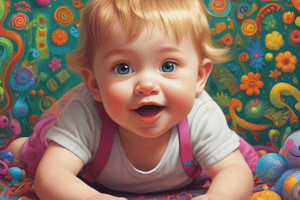Podcast
Questions and Answers
What is the primary difference between cephalocaudal and proximodistal growth patterns?
What is the primary difference between cephalocaudal and proximodistal growth patterns?
- Cephalocaudal refers to emotional growth, while proximodistal refers to cognitive growth.
- Cephalocaudal refers to growth from head to toe, whereas proximodistal refers to growth from the center of the body outward. (correct)
- Cephalocaudal is related to muscle growth, whereas proximodistal is related to bone development.
- Cephalocaudal focuses on the development of fine motor skills, while proximodistal focuses on gross motor skills.
Which of the following reflexes is classified as a postural reflex?
Which of the following reflexes is classified as a postural reflex?
- Moro reflex (correct)
- Palmar grasp reflex
- Plantar grasp reflex
- None of the above
What is an important characteristic of sarcopenia in aging?
What is an important characteristic of sarcopenia in aging?
- It leads to increased agility in older adults.
- It is the loss of muscle mass and strength. (correct)
- It occurs exclusively in those who are physically inactive.
- It only affects lower body muscles.
How does haptic perception evolve within the first year of life?
How does haptic perception evolve within the first year of life?
What are the implications of unilateral and cross-lateral eye dominance in movement activities?
What are the implications of unilateral and cross-lateral eye dominance in movement activities?
What is the main purpose of chorionic villus sampling and amniocentesis?
What is the main purpose of chorionic villus sampling and amniocentesis?
What are the effects of polypharmacy in older adults?
What are the effects of polypharmacy in older adults?
What distinguishes aggregate stage in development?
What distinguishes aggregate stage in development?
Which term refers to the reflexes that are exhibited automatically in response to specific stimuli during infancy?
Which term refers to the reflexes that are exhibited automatically in response to specific stimuli during infancy?
What describes the condition when older adults experience decreased muscle mass and strength?
What describes the condition when older adults experience decreased muscle mass and strength?
Which of the following accurately describes the components of fine and gross motor skills?
Which of the following accurately describes the components of fine and gross motor skills?
What is the significance of eye dominance in movement activities?
What is the significance of eye dominance in movement activities?
Which prenatal diagnostic technique involves sampling the amniotic fluid?
Which prenatal diagnostic technique involves sampling the amniotic fluid?
What could be a consequence of declining flexibility in older adults?
What could be a consequence of declining flexibility in older adults?
What term is used to describe the ability to perceive and interpret tactile information?
What term is used to describe the ability to perceive and interpret tactile information?
Which of the following best describes the term 'critical period' in development?
Which of the following best describes the term 'critical period' in development?
Flashcards
Creeping & Crawling
Creeping & Crawling
Early motor skills involving movement on hands and knees, or using belly-to-hand support, and advancing towards crawling position.
Prenatal & Neonatal Periods
Prenatal & Neonatal Periods
Prenatal: period before birth; Neonatal: period after birth (first few weeks).
Cephalocaudal & Proximodistal
Cephalocaudal & Proximodistal
Cephalocaudal: development from head to toe. Proximodistal: development from center of body outwards.
Fine & Gross Motor Skills
Fine & Gross Motor Skills
Signup and view all the flashcards
Primitive Reflexes
Primitive Reflexes
Signup and view all the flashcards
Critical Period & Catch-up
Critical Period & Catch-up
Signup and view all the flashcards
Growth & Maturation
Growth & Maturation
Signup and view all the flashcards
Chorionic Villus Sampling & Amniocentesis
Chorionic Villus Sampling & Amniocentesis
Signup and view all the flashcards
Play
Play
Signup and view all the flashcards
Postural Reflexes
Postural Reflexes
Signup and view all the flashcards
Miles Himmelreich & 'Bubble Trouble'
Miles Himmelreich & 'Bubble Trouble'
Signup and view all the flashcards
Obesity Prevalence
Obesity Prevalence
Signup and view all the flashcards
Declining Flexibility with Age
Declining Flexibility with Age
Signup and view all the flashcards
Eye Dominance
Eye Dominance
Signup and view all the flashcards
Sarcopenia
Sarcopenia
Signup and view all the flashcards
Gait Patterns in Early vs. Late Adulthood
Gait Patterns in Early vs. Late Adulthood
Signup and view all the flashcards
Study Notes
Sample Questions - KIN 180 Growth & Development
- Part 1: Key terms and their significance (importance)
- Creeping and crawling
- Chorionic villus sampling & amniocentesis
- Palmar grasp & plantar grasp reflex
- Prenatal & neonatal periods
- Cephalocaudal & proximodistal development
- Fine & gross motor skills
- Growth & maturation
- Midwife & doula
- Primitive & postural reflexes
- Critical period & catch-up growth
- Epiphyseal plates
- Aggregate stage
- Ectomorph, endomorph, & mesomorph body types
- Age-related macular degeneration
- Glaucoma & cataracts
- Moro reflex
- Polypharmacy
- Gait
- Health literacy & physical literacy
- Snellen eye charts
- Last-in-first-out hypothesis
- Prehension & haptic perception
- Homolateral & contralateral throwing
- Unilateral & cross-lateral eye dominance
Part 2: Questions for Short and Potentially Longer Answers
- Play: Four categories, importance
- 8 Significant facts of development: 5 examples needed
- Postural reflexes: Characteristics, four examples
- Miles Himmelreich's "bubble trouble"
- Obesity prevalence (US/Canada): Reasons
- Declining flexibility with age: Causes
- Eye dominance: Testing, implications for movement
- Sarcopina: Impact on aging
- Reasons for children participating in sports (top 10):
- Gait differences (early vs. late adulthood)
- Benefits of successfully completing KIN 180 assignments
- Haptic perception: Description, first-year evolution
- Chronological vs. developmental age: Differences, four methods of determining
- Long-term Athlete Development Model (7 stages and ages): Description
- Stages of drawing (4 stages): Description and sample
- "Cells that fire together, wire together": Meaning and motor development significance
- 5 Prenatal diagnostic procedures: Description
- Developmental sequences of skills (body approach): Example of running and catching skills
- Precious puberty: Problems in development
- Helping a pregnant woman (in a taxicab): Information required
- Fundamental locomotor vs. object control skills: Description, skills provided
- Volleyball modifications (children 6-8): Developmentally appropriate adjustments
Studying That Suits You
Use AI to generate personalized quizzes and flashcards to suit your learning preferences.




